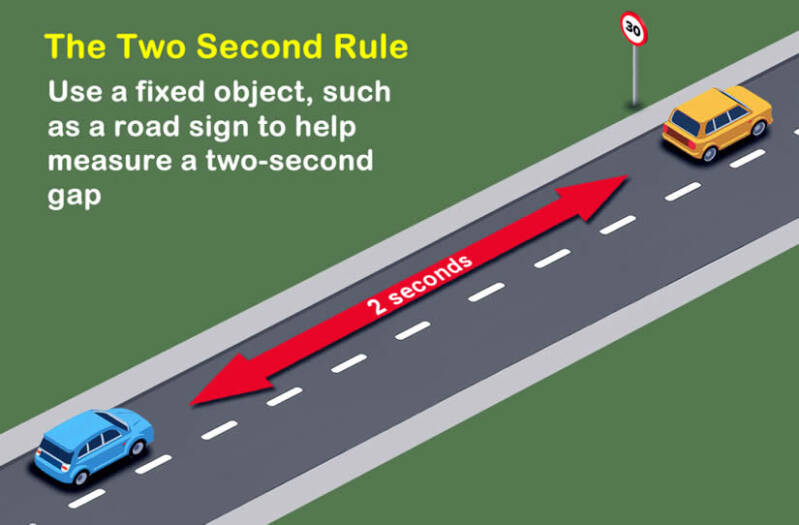Safety margins
Safety margins are the distances we allow between our car and other vehicles. By implementing these buffers reduces the risk of a collision if something unexpected should happen.
When we are stationary, we must allow a safe space between our car and the vehicle in front. The distance is about half a cars length but to help measure this we can use the "tyres & tarmac" rule.

From the drivers position, we should be able to see the rear tyres of the car in front and about 1 meter of the road (tarmac) surface behind that car.

By leaving at least this size gap reduces the risk of a collision if the car in front should roll back. It also allows us a better chance of spotting any road markings ahead.

If we are stationary behind a larger vehicle, we must leave a bigger gap. To measure a safe distance we should be able to see the top on the roof and/or the wing mirrors of the vehicle in front. If we can see their wing mirrors, they can see us.
Other common safety margins we have spoken about involve passing parked cars. By leaving at least a doors width will avoid a collision should the door of the parked car open. If we cannot leave a doors width, we must reduce our speed to allow time to stop if the worst should happen.

We must also leave a safe distance when passing vulnerable road users like pedestrians, cyclists or horse riders.
These are the Highway code rules for passing vulnerable road users:
Cyclists 1.5m at speeds up to 30mph, more space at higher speeds
Horse riders At least 2m and no faster than 10mph
Pedestrians At least 2m and no faster than 10mph
This can be a lot to remember, so applying a little common sense can work more effectively.

For example, when looking to pass a cyclist, think of a worst case scenario...the cyclist falls off their bike into the road, are you leaving enough distance so you don't run them over?
What about speed? Put yourself in their situation, at what speed would you be comfortable with a car passing you?
Another safety margin we need to implement is the distance from the vehicle in front of us when moving. This is called braking distance.
Braking distance can be broken down into two elements, "thinking distance" is the time it takes us to react if the car in front should brake and "stopping distance" is the time it take for our vehicle to come to a complete stop. This chart below shows how our braking distance increases as our speed increases in a car, in dry conditions.

These speed specific distance are not practical to remember or judge when driving. Instead we can apply the "2 second rule".

There are factors that may change this 2 second gap. For example, if the car behind us was not leaving a safe distance, should the car in front of us suddenly break, we could stop in time, but the car behind might not. By increasing our breaking distance, we can slow down at a slower rate to manage the risk behind us.
Other factors can include the load we are carrying, if we have a car full of passengers, the extra weight will require a greater breaking distance.
The road surface is also a factor, if the road is wet, we must double the distance creating a 4 second gap. If there is snow or ice on the road, this distance must increase by a factor of 10, creating a 20 second gap.
